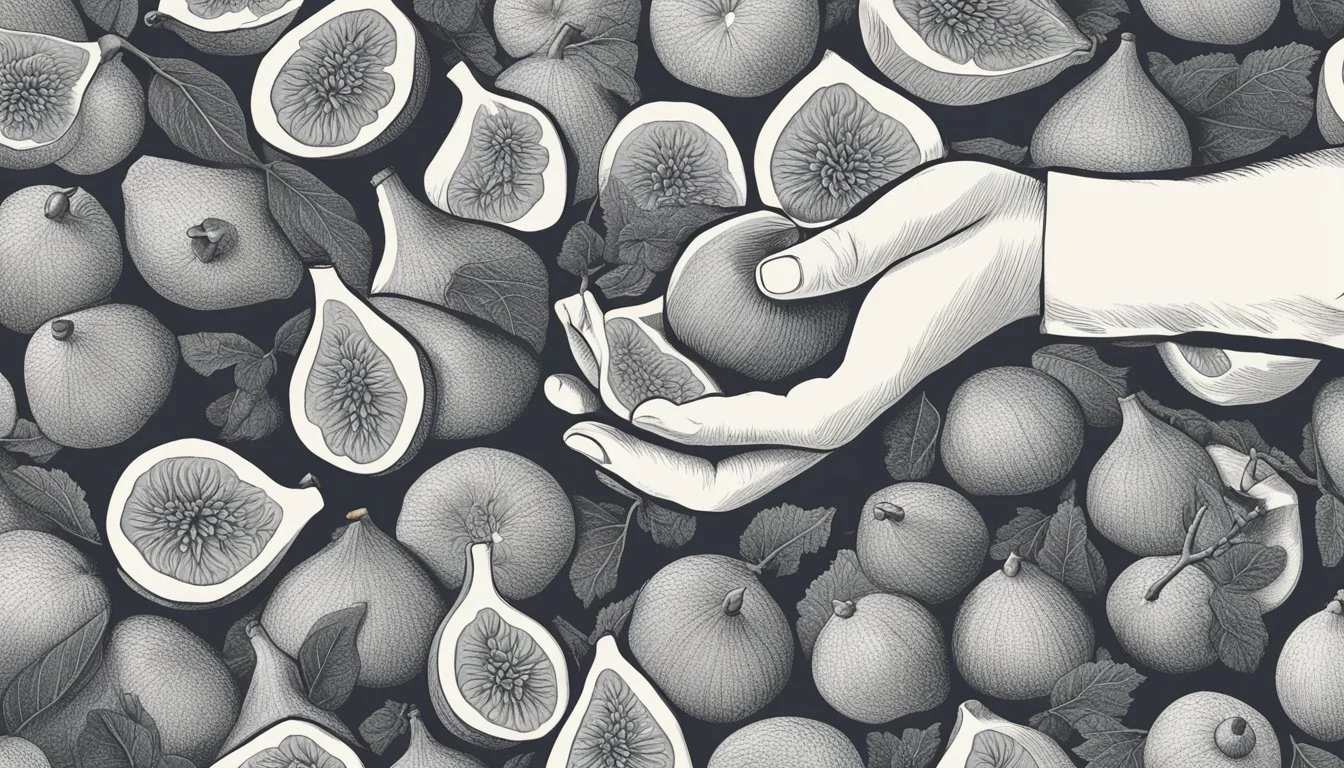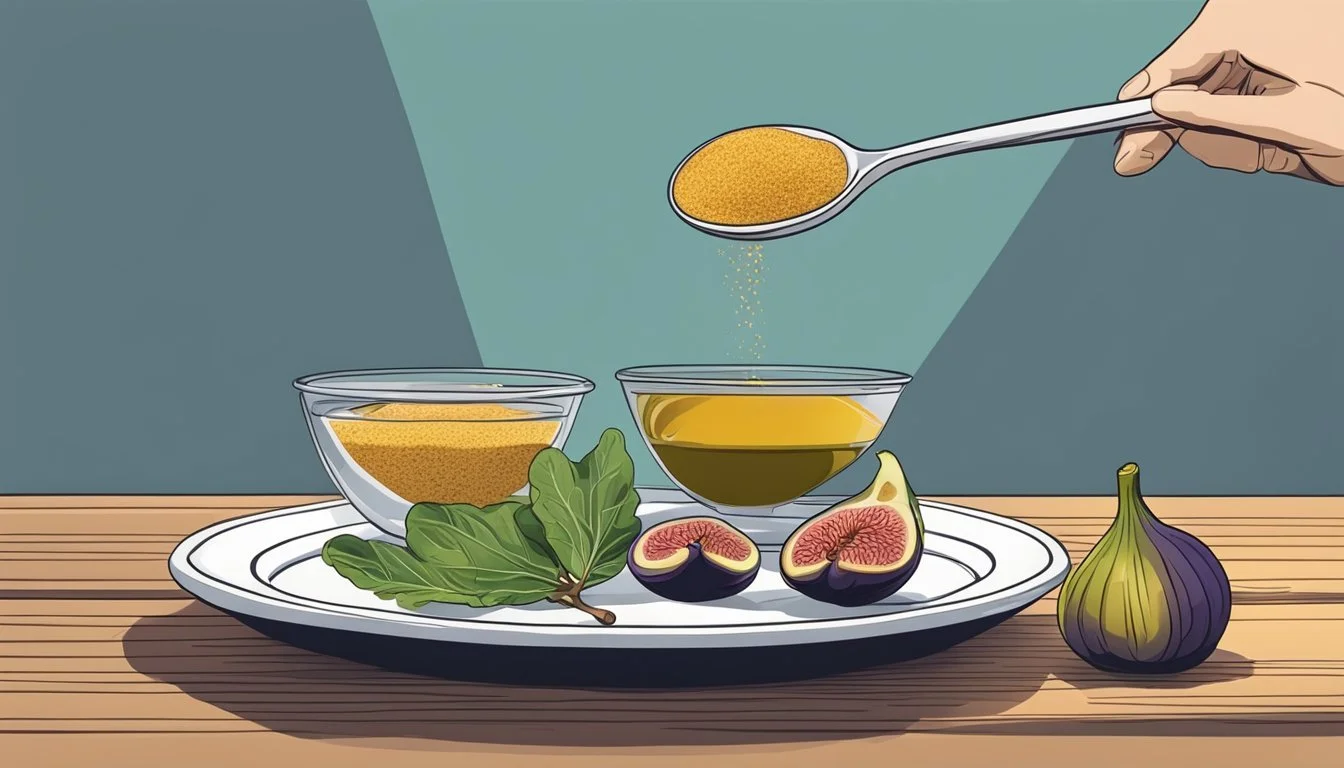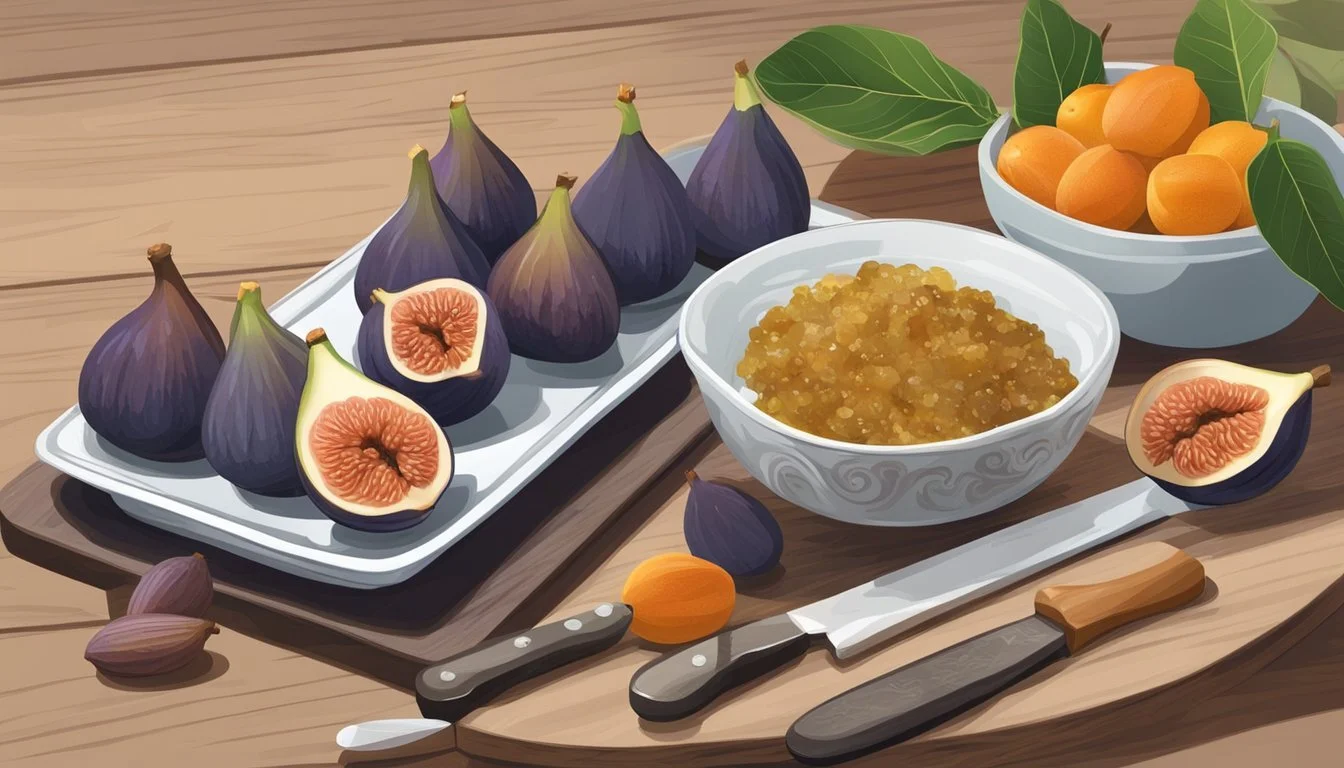Fig Substitutes
Top Alternatives for Your Recipes
Figs are a unique fruit with a rich, honeyed taste and a soft, chewy texture that can be a delightful addition to various dishes, from savory plates to sweet desserts. They come in fresh and dried forms, each offering distinctive flavors and culinary opportunities. However, fig availability can be seasonal or they might be difficult to find in some regions, prompting cooks to seek out suitable substitutes. When fresh figs are not an option, several alternatives provide complementary flavors and textures that can adapt to most recipes calling for this fruit.
Dried figs are a common go-to replacement for their fresh counterparts because they preserve much of the same flavor profile, albeit in a more concentrated form. Other alternatives include dates, which are similarly sweet and can be added to salads (What wine goes well with salads?) , stuffed for appetizers, or pureed to make spreads. Apricots and prunes offer a sweet-tart taste that works well in baked goods and savory dishes. For a similar texture to fresh figs, pears can be a fitting substitute, especially in cooked recipes.
The key to selecting a fig substitute lies in the desired outcome of the dish, considering both the sweetness and texture the recipe requires. While no replacement will perfectly mimic the flavor and consistency of figs, many fruits like raisins, cranberries, and apricots can be excellent stand-ins, especially in figs' most common uses such as snacking, in pies, jams, and as a complement to cheese platters. The selection process involves trial and refinement, as each substitute brings its own unique attributes to the table.
Understanding Figs
Figs, with their unique taste and texture, play an essential role in a variety of cuisines. They are characterized by their sweetness and a texture that combines a chewy flesh with a smooth skin and crunchy seeds.
Types of Figs
There are several main varieties of figs that are popularly consumed:
Black Mission: Known for its deep purple to black skin, the Black Mission fig has a sweet and intense flavor.
Brown Turkey: A fig with brownish-purple skin and a milder flavor than the Black Mission. It is often larger and less sweet.
Kadota: This fig has green skin and purplish flesh and is less sweet than other types, yet still has a pleasant honey-like flavor.
Adriatic: Often used to make fig bars, this variety has light green skin with pink flesh and a very sweet flavor.
Nutritional Profile
Figs, whether fresh or dried, offer a range of vitamins and minerals while also providing dietary fiber. Here's a quick look at their nutritional composition:
Calories: A medium-sized fresh fig typically contains about 30 to 50 calories, while a similar serving of dried figs contains about 85 to 110 calories due to the concentration of sugars when the water is removed.
Fiber: Figs are high in fiber, which is beneficial for digestive health.
Vitamins and Minerals: They are a good source of various vitamins, including Vitamin B6 and minerals such as potassium, magnesium, and calcium.
Culinary Uses
Figs have a variety of culinary applications:
Fresh Figs: Enjoyed for their soft texture and sweet, juicy flavor, they are commonly eaten raw, included in salads, or served with cheeses on charcuterie (What wine goes well with charcuterie?) boards during their peak season.
Dried Figs: Due to their availability year-round, dried figs are a popular alternative, offering a concentrated fig flavor and a chewy texture suitable for baking and cooking.
Fig Season: The peak season for fresh figs is typically from late summer to early autumn, making this the best time to enjoy them in their freshest form.
Figs' versatility allows them to be included in sweet and savory dishes, from jams and pies to braises and roasts, bringing a unique flavor profile that complements a variety of ingredients.
Selecting Fig Substitutes
When choosing substitutes for figs, one should consider how closely these alternatives mimic the flavor and texture of fresh figs. The selection process involves understanding the criteria for substitution and considering the availability and seasonality of these alternatives.
Criteria for Substitution
The ideal fig substitute should provide a similar sweetness and texture to that of fresh figs. In recipes where figs are a significant ingredient, substitutes should have the capacity to be used in the same quantity as figs without drastically altering the dish's outcome. Dried fruits such as apricots, plums, and dates often serve well due to their concentrated sweetness and chewy texture. Their use in snacking, baking, or as part of a charcuterie board makes them versatile options.
For cooked applications like braising and roasting, fig jam or apricots can impart a comparable flavor and moisture content. In salads, dried dates or sultanas offer the necessary sweetness, while for baking, raisins can be a suitable substitute, with golden raisins being particularly sweet and fitting for sweeter dishes.
Use Case Recommended Substitutes Snacking Apricots, Plums, Dates Baking Raisins, Dates, Apricot Salads Dates, Sultanas Braising & Roasting Apricots, Fig Jam Charcuterie Boards Dates, Quince
Availability and Seasonality
Fresh figs have a limited season, typically from mid-summer to fall, which necessitates consideration of substitutes during off-season periods. Grocery stores carry various dried fruits and jams year-round, making them accessible alternatives. Substitutes for fresh figs in their prime season might be available in the fresh fruit section, such as pears or apricots. When fresh figs are not in season, one might find that dried figs or fig preserves offer the closest match in flavor for most recipes requiring figs.
When selecting fig substitutes, the availability of the alternative fruit should align with the window of need. Perishable fruits like apricots have their season and may not always be available but dried versions often are. It's important to consult the produce and dried fruit sections of the grocery store to determine which substitutes are currently accessible.
Fruit-Based Substitutes
When seeking alternatives to figs in recipes, considering the textural and flavor profiles of potential fruit substitutes is crucial. Choosing the right fruit can ensure the dish maintains its intended taste and consistency.
Dried Fruit Alternatives
Dried fruits offer a convenient, year-round substitute for figs and carry intense flavors suitable for numerous culinary applications.
Dates: They are rich in sweetness and can be used in dessert recipes or salads. Medjool dates, noted for their larger size and caramel-like taste, are particularly prized.
Prunes: Known for their deep flavor and fibrous content, prunes work well as a fig replacement in stewed or braised dishes.
Apricots: Dried apricots provide a tangy sweetness that complements both savory and sweet recipes.
Raisins and Golden Raisins: The former adds a standard sweet note, while the latter, with a lighter and fruitier profile, is excellent for salads and grain dishes.
Cranberries: These tart dried fruits can add a zesty punch to dishes needing a lift in flavor.
Fresh Fruit Options
The freshness of fruit can add moisture and a delicate aroma to dishes, making them suitable as fig substitutes when their dried counterparts are less desirable.
Pears: When ripe, pears have a soft texture and a sweet, floral flavor that can mimic the mildness of figs in fresh applications.
Strawberries: Their sweetness and slight acidity can serve as a pleasant fig substitute in desserts and salads.
Peaches and Nectarines: With their juicy and sweet profile, these stone fruits are ideal in dishes where a softer, succulent texture is beneficial.
Plums: Available in various types, plums can replace figs with their diverse range of sweet to tart flavors.
Apricots (Fresh): Similar to their dried form but with a juicier bite, fresh apricots can be used in both savory and sweet contexts.
Using these fruit-based substitutes, cooks can adeptly replace figs in recipes without compromising on the overall flavor of the dish. Whether one opts for dried or fresh alternatives, each fruit offers its own unique qualities that can emulate or even enhance the character of figs within culinary creations.
Sweet and Savory Pairings
Selecting the right fig substitute can elevate both sweet and savory dishes, complementing cheeses and meats with succulence, enriching desserts and baking with moistness, and enhancing salads and jams with depth of flavor.
Cheeses and Meats
For cheese platters and charcuterie boards, the sweetness of dried fruits like apricots and dates pairs well with a variety of cheeses, especially sharp ones. They can also stand in for figs to complement the saltiness of meats like pancetta. Using quince paste provides a delightful juxtaposition against rich, creamy cheeses, while fig jam works as a condiment to balance the savory flavors of assorted meats.
Desserts and Baking
In desserts and baking, substitutes for figs must provide moisture and sweetness. Dried apricots and medjool dates are excellent choices to incorporate into cakes and cookies. They maintain a sticky richness suitable for pastry fillings just as well as figs do. For a twist in flavor profile, prunes can be used to achieve a similar texture and sweetness in baked goods.
Salads and Jams
Salads benefit from the addition of sultanas or golden raisins, which add a pop of sweetness and texture. For a more tart flavor profile, cranberries can serve as a fig substitute in both salads and jams. They contribute a vibrant burst against the greens and are also rich in vitamins, which can be especially helpful during cold seasons. In the context of jams, utilizing pear or apricot can mimic the velvety consistency expected from fig spread.
Substitute Preparation Techniques
Proper preparation of fig substitutes can significantly affect the final outcome of a dish. The following methods will guide one to effectively use alternative ingredients while maintaining the desired flavor and texture in fig recipes.
Rehydrating Dried Fruits
To rehydrate dried fruits such as apricots, prunes, or raisins, one should soak them in warm water or juice for about 15 to 30 minutes until they plump up. This process restores moisture and makes them a suitable replacement for fresh figs in recipes where a tender texture is required. Ensure that the water is not too hot as it can cook the fruits and alter their flavor profile.
Procedure: Soak in warm water/juice
Duration: 15-30 minutes
Result: Tender texture similar to fresh figs
Creating Compotes and Pastes
Compotes and pastes can be made by cooking down fruits such as pears, apricots, or dates with a little bit of water and sugar until they break down into a thick, jam-like consistency. These are excellent for pie fillings or as a spread to mimic the taste and texture of figs in various dishes.
Ingredients: Selected fruit, water, sugar
Cooking Time: Varies until thick consistency is achieved
Usage: Pie fillings, spreads
Mincing for Texture
When using fruits such as apricots or dates as a fig substitute, mincing them finely can help match the texture profile of figs in dishes like salads or baked goods. They blend seamlessly into the recipe, providing a similar mouthfeel and distribution of sweetness throughout the dish.
Method: Fine mincing with a knife
Benefit: Similar texture to figs
Suitable for: Salads, baked goods
Seasoning and Taste Adjustments
When substituting figs in a recipe, one must consider both the unique taste profile figs contribute and the adjustments in seasoning that may be necessary to achieve a similar flavor balance.
Matching the Taste of Figs
Figs are known for their sweet and rich flavor with a hint of earthiness, which can be complemented by certain fruits and sweeteners. Dried fruits like sultanas and dates can mimic the sweetness and texture of figs. The use of honey can also bring a similar natural sweetness to dishes. Below is a breakdown of possible substitutes and their characteristics:
Substitute Taste Characteristic Texture Similarity Sultanas Sweet with a slight tartness Close, but less chewy Dates Deeply sweet, caramel-like Similar chewiness Honey Natural sweetness, varies by source Liquid, no texture similarity
Balance with Spices and Sweeteners
The inherent sweetness of figs often pairs well with warm spices and nuts in both savory and sweet dishes. One may consider a balanced addition of cinnamon or nutmeg to replicate the aromatic warmth that figs provide. Nuts, especially walnuts or pecans, can introduce a complementary crunch and nuttiness. Here are some suggested combinations:
For baking: a pinch of cinnamon with honey as a sweetener.
For savory dishes: a sprinkle of nutmeg with chopped dates to bring sweetness and texture.
Remember, the key is to start with small quantities when incorporating spices and sweeteners, tasting and adjusting incrementally to reach the desired flavor profile.
Complementary Pairings with Substitutes
When selecting substitutes for figs in culinary preparations, it's important to consider how these alternatives will interact with other components of the dish, especially with wine and nuts which can enhance flavor profiles.
Wine Pairings
Cheese Platter: When offering dates or apricots as fig substitutes on a cheese platter, one might pair them with a medium-bodied Merlot to complement the sweetness with its ripe, red fruit notes.
Braised or Roasted Dishes: If apricots are used in lieu of figs for braising meats, a glass of full-bodied Syrah, noted for its dark fruit flavors and spicy undertones, can balance the dish's rich taste.
Salads with Citrus Fruits: Utilizing sultanas or raisins in salads alongside citrus fruits pairs well with aromatic white wines like Sauvignon Blanc, enhancing the zestiness with its crisp acidity.
Balancing Flavors with Nuts
For dishes that integrate fig substitutes, including nuts can help create a balanced flavor.
With Mild Cheeses: When prunes or quince adjoin a cheese selection, almonds offer a delicate contrast that doesn't overpower the subtle sweetness of the fruit.
In Sweet Breads or Desserts: In baked goods where raisins or dried apricots replace figs, walnuts provide a robust, earthy flavor that complements the fruit's natural sugars.
For Meat Dishes: Pair golden raisins used in pork or chicken dishes with pine nuts for a subtle, buttery crunch that can accentuate the meat's savory profile.
Shopping for Substitutes
When seeking alternatives to fresh figs, consumer shopping options generally fall within the domains of local grocery stores or specialty markets. These two types of retail environments offer a range of suitable fig substitutes that can be used in various culinary applications.
Grocery Store Finds
At most grocery stores, shoppers will encounter a selection of dried fruit which typically includes dried dates and canned figs. These items are often located within the produce section or the baking aisle.
Dried Dates: Found in the produce section, these sweet fruits are excellent for snacking and can be used in salads. Medjool dates, known for their large size and sweet flavor, make a particularly good substitute for figs due to their similar texture.
Canned Figs: While not as common, some grocery stores may stock canned figs. These can be a handy alternative, particularly for pie fillings or jams, when fresh figs are out of season.
Bartlett pears and Bosc pears also work well as fresh replacements. They are typically easy to find in the fresh fruit aisle.
Substitute Aisle Use Cases Dried Dates Produce/Baking Snacking, Salads, Desserts Canned Figs Canned Goods Pie Fillings, Jams Bartlett Pears Fresh Fruit Fresh Eating, Cooking, Baking Bosc Pears Fresh Fruit Fresh Eating, Cooking, Baking
Specialty Markets Insights
For shoppers who frequent specialty markets, the options for fig substitutes expand. These stores may carry a wider variety of dried fruits or even offer more exotic or less common items.
Specialty markets might stock high-quality dried dates, including unique varieties beyond Medjool. These dates could be sold in bulk, offering a cost-effective substitute for figs.
In terms of pears, specialty markets often provide a broader spectrum, including heirloom varieties that are not typically found in grocery stores. Both Bartlett and Bosc pears are excellent choices for cooking and baking due to their flavor and texture, but specialty stores might offer other varietals that can serve as an intriguing substitute to figs.
While some fig substitutes may be unique to your local market’s offerings, shoppers can generally rely on dried dates, canned figs, and various types of pears as dependable alternatives found within both grocery stores and specialty markets.









